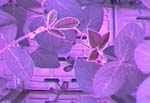Zeolite research resumes aboard International Space Station:
by Steve Roy, Marshall Space Flight Center
More articles in ISSThe first sample runs of the Zeolite Crystal Growth (ZCG) experiment during Expedition Five are under way this week aboard the International Space Station, offering potential improvements in the printing industry and transmitting electronic data. Other Station experiments, including one to grow soybeans, continued to function well. Space Station science experiments and payload operations are managed by the Payload Operations Center at the Marshall Center.
Soybean plants aboard Space Station Photo: Click image to view time-lapse image of soybean plants aboard Space Station. (Wisconsin Center for Space Automation and Robotics)

Time-lapse image of soybean plants aboard Space Station This series of time lapse images taken between June 11 and July 2 shows soybean plants growing in the Advanced Astroculture experiment aboard the International Space Station. DuPont is partnering with NASA and the Wisconsin Center for Space Automation and Robotics (WCSAR) at the University of Wisconsin-Madison to grow soybeans aboard the International Space Station to find out if they have improved oil, protein, carbohydrates or secondary metabolites that could benefit farmers and consumers. Soybeans are the largest single source of protein meal and vegetable oil in the human diet. After a 70-day growth period, plants and harvested grain will be returned to Earth for analysis. Small animation, 72 KB, large animation, 592 KB (Wisconsin Center for Space Automation and Robotics)
The first sample runs of the Zeolite Crystal Growth (ZCG) experiment during Expedition Five began last Thursday, offering potential improvements in the printing industry and transmitting electronic data.
The science team on the ground reported this week that they are receiving good data. The critical first 10 hours went normally with the temperature levels rising just as expected. ZCG is scheduled to process samples for 15 days.
During the critical first 20 hours of crystallization, the Active Rack Isolation System operated to damp stray vibrations from the crew or operating equipment. It was put in hold mode during the docking of the Russian Progress 8 cargo ship on Saturday but was back in active mode on Monday.
Zeolites have the ability to absorb liquids and gases such as petroleum or hydrogen but remain hard as a rock, giving up their contents only when heated or under reduced pressure. They form the backbone of the chemical processes industry, including, for instance, in production of virtually all the world's gasoline. In space, scientists hope the ZCG experiment will produce larger, more perfect crystals for study back on the ground. ZCG research began during Expedition Four. The samples processed during Expedition Five, however, have never flown before in space, said Dr. Al Sacco, director of the Center for Advanced Microgravity Materials Processing at Northeastern University in Boston.
"Everything is going wonderfully at this time," said Sacco, a payload specialist aboard STS-73 in 1995. "The samples are all different from our three previous zeolite experiments aboard the Space Shuttle and Expedition Four aboard the Station. One of them is looking at a way to trap dyes for carbonless paper, fixing the dyes so print doesn't fade. The other one is looking at the process for growing the first continuous quantum wires in orbit for the next generation of electronics. Instead of electricity, these wires would transmit light."
The crew completed a nutrient fluid exchange in the Advanced Astroculture experiment last Thursday, removing 210 milliliters of fluid and injecting 500 milliliters of fresh nutrient fluid for the soybean plants growing inside.
On Friday, the crew completed the monthly background reading on the EVA Radiation Monitoring badges and downloaded the data to the Human Research Facility (HRF) laptop computer. The data, along with Pulmonary Function in Flight data obtained two days earlier was downlinked to the ground. Fifty-one files were received.
On Saturday, at the request of the Principal Investigator Dr. Aniruddha Achari, Flight Engineer-2 Peggy Whitson deactivated one of the growth cylinders in the Protein Crystal Growth Single Thermal Enclosure System. The remaining cylinders continued operating normally.
Also on Saturday, ground controllers and the crew completed checkout work with the Microgravity Science Glovebox including mechanical inspection and filter installation and inspection. The Glovebox ground team is re-verifying procedures in preparation for the first scientific research using the Glovebox.
The crew on Tuesday and today completed their Crew Interactions surveys on The crew on Tuesday and today completed their Crew Interactions surveys on the HRF laptop computer.
After a day off on July 4, the crew on Friday is scheduled to set up and take documentation photos of the Solidification Using a Baffle in Sealed Ampoule (SUBSA) experiment in preparation for operations next week. SUBSA is a Glovebox experiment that will examine the behavior of molten materials used in semiconductor manufacturing.
Crew Earth Observations (CEO) photography subjects this week included air quality over the Mediterranean, Saharan dust over the western Mediterranean, coastline and erosional features in the Gulf of St. Lawrence, dust storms near the Cape Verde islands, and air quality over the Ohio River valley.
Editor’s Note: The Payload Operations Center at NASA's Marshall Space Flight Center in Huntsville, Ala., manages all science research experiment operations aboard the International Space Station. The center is also home for coordination of the mission-planning work of a variety of international sources, all science payload deliveries and retrieval, and payload training and payload safety programs for the Station crew and all ground personnel.